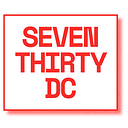Selected and Rejected: DC’s Own Salon of the Refused
If you’ve been to The Phillips Collection since mid-July, you’ve likely seen Inside Outside, Upside Down, a juried exhibit of “dynamic work across media by 64 artists of the greater DC region.”
But you may not have seen its underground counterpart: Salon of the Refused DC, which is showcasing work submitted to and rejected from the Phillips exhibit.
The original “salon of rejects” (a more accurate translation of the original Salon des Refusés) was hosted in 1863 and had an important role in breaking down the judgment, exclusivity, and gatekeeping that defined the French art scene. The Paris Salon, which was something like the American Idol of the 19th Century (a massively popular showcase of contemporary art), began to lose its place as a rule-setting and boundary-defining authority.
Salon of the Refused DC has posted 52 works of art so far and has about 100 followers on Instagram at the time of this interview. Just like the accepted works at the Phillips, the pandemic and the racial unrest that has defined life since 2020 are prominent. According to the folks behind the online exhibition, over 800 artists submitted work that was rejected from The Phillips Collection.
We emailed with Matt Malone, the artist behind @salonoftherefuseddc to learn more about the project and its goals.
Were you one of the 800 artists whose work was rejected?
Yes, (just slightly bitter ;) lol) but that motivated me to create the Salon of the Refused. The image I used to promote the event (seen below) is a collage I created from found/discarded materials while in art school in 2005 at VCU after I was rejected from a call to the Virginia Museum of Fine Arts (VMFA). A teacher gave me the advice to save everything because you never know when something might be of use later in life.
What does being accepted to a juried invitational such as this one mean to an artist?
It is a great honor and can really help an artist’s career in terms of public exposure, validating/giving credibility to their work to collectors, gaining gallery representation, and facilitating sales. I also reached out to a few of the artists that did get accepted to the show as well. Artists were allowed to submit two (2) works to the Phillips call and my hope was they would show one of their “rejected” works to the Salon of the Refused DC. It would be cool to see the contrast. No one decided to do it though. I’m not sure why, maybe it would take away some of the credibility of being accepted noted in my response above.
How competitive is the DC art community?
I only received a fraction of the rejected submissions but judging by the responses, it is very competitive in terms of a secondary Art Hub (compared to NY / LA).
There is also an artistic “competition” in the Graffiti/tagging all around the city. especially since Covid hit. You see a lot of buildings being sold or remodeled and during the in-between stages, graffiti or tags go up immediately. Also, there are many different murals business owners commission for their spaces too and I know there is a lot of competition for those projects.
Do artists generally support each other, regardless of their success in or desire to be accepted to juried shows?
Yes, there are so many factors at play when it comes to a juried show that you have to take acceptance/rejection with a grain of salt. Most artists will tell you they get rejected wayyy more than accepted.
I feel all artists need to find some form of a supportive peer group. It helps them to stay motivated, generate new ideas, and most importantly to keep working. As a collaborative artist, I always found that being held accountable by another artist kept me from being complacent, making excuses, or just being lazy.
How do the pressures of applying to an exclusive show like this one affect artists’ art?
I don’t feel an artist should cater to or alter their work just to get into a show or make what they think the juror will like, it is not genuine and that usually shows. Most calls (including this one) involve a theme which is open-ended and not so restrictive as to force an artist to change their work. The point is to convey your views or expressions. The pressure to make something worthy of a show like this is motivating and can help push an artist to be more critical of their work, take risks, as well as seek constructive feedback from others.
What makes the current DC art scene distinctive?
I feel it is currently in the process of trying to carve out its own identity. It has not necessarily unified together to a point where there is one distinct feature, maybe that is what is distinct about it. With that said I think there is a conscious effort being made to create a DC scene that is true to the city. It involves an awareness of the past, present, and potential future. All 4 quadrants have so much diversity.
Have any of the rejected works created a bigger reaction than the rest?
A work by artist Mira Hecht: Elegy in Red, Oil On Canvas, has the most engagement. On some images, we get the comments like… How was this not accepted? — in particular for Hope and Faith’s image Sadie’s Home, a mixed media collage.
What do you hope viewers of the virtual showcase take away from their visit to your Instagram page?
My hope for viewers (non-artists) is that it opens their eyes to all the different types of work being created out there. Also, that just because something is not in a gallery or validated by the “establishment” it still has merit. The original 1863 Salon of the Refused proves this. I also hope it encourages them to be confident in their tastes. If they see and like artwork that is not in a specific gallery or selected to a show don’t use that as an excuse not to support the artist. Find a way to acquire the work. They will appreciate it way more than a poster of Van Gogh’s Starry Night.
And what do you hope artists take away from it?
I hope artists take away that getting rejected never feels good, but it happens to everyone. Hopefully seeing how good the rejected work is keeps them motivated to keep producing no matter what setbacks occur. We all need to support each other.
Anything else you’d like to share?
I have been a juror so I know firsthand it is a difficult task, especially when viewing images online. It is so easy for details in a work to be lost or overlooked.
I used to be an employee of the Phillips Collection back in 2009 as a museum guard. I love the museum and a lot of my “art education” was developed there standing in a room with amazing paintings for hours on end. While working there I met another artist, Kurtis Ceppetelli and we have been working collaboratively painting together for the past 11 years under the name Duly Noted Painters.
This interview has been edited for length and clarity

